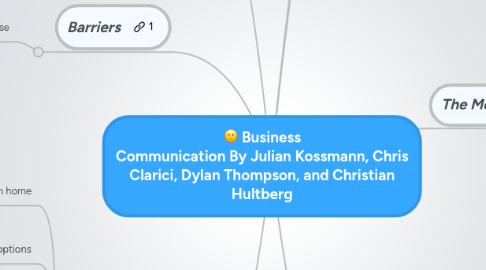
1. To Whom?
1.1. The potential audience of the message
1.2. Indicates the formality of the message
1.3. Must use language that the audience can understand
1.4. The sender should make sure that they are sending their message to the correct audience. Especially if a reply is requested.
2. Role of ICT
2.1. Allows employees to work from home
2.1.1. By having the technology to be able to work from a number of locations away from the organisation's main offices (including at home)
2.1.1.1. Good for: Sick employees Maternity leave Employees on business trips etc.
2.2. Outsourcing and offshoring are now options
2.2.1. Can hold them accountable
2.3. Benefits
2.3.1. Cheaper
2.3.2. Simpler
2.3.3. Quicker
2.4. Allows businesses to receive instant feedback on goods and services and to reach different markets
2.4.1. Twitter
2.4.2. Facebook
2.5. Increase in employee mobility
2.6. Types of ICT:
2.6.1. Fax
2.6.2. Email
2.6.3. Intranets
2.6.4. Video conferencing (e.g. Skype)
2.6.5. Telephone conferencing
2.6.6. Mobile phone/smart phone
2.6.7. World wide web
3. Barriers
3.1. Referred to as noise
3.1.1. Noise in which are able to be blocked or distorted
3.1.1.1. International Communication
3.1.1.1.1. Distance
3.1.1.1.2. Languages
3.1.1.1.3. Cultural
3.1.1.1.4. Countries' Development
3.1.1.2. Society/People
3.1.1.2.1. Prejudice of people or Preconceptions
3.1.1.2.2. Past Experiences/Background
3.1.1.2.3. Lack of Training and Education
3.1.1.3. Poor Selection of Medium of Communication
4. If communication is good
4.1. Change is encouraged and transitions are easie
4.2. Commitment is developed among staff (and therefore enhances motivation)
4.3. Co-ordination within the organisation is more effective (therefore ensuring that the efficient implementation of plans and strategies)
4.4. Clear roles and responsibility
5. Value
5.1. If communication is bad
5.1.1. Problems are not identified and addressed
5.1.2. Leaders becoming isolated and follow events rather than shaping them
5.1.3. Department rivalries develop
5.1.4. Motivation and morale may be affected
6. The Medium
6.1. Oral, Written, Visual, or Non-Verbal
6.1.1. Oral-Any communication that takes place individuals and using speaking and listening. This is used predominantly in businesses in forms such as meetings, personal discussions, and presentations.
6.1.2. Non verbal-All forms of communication that do not use the spoken word such as written and visual communication.
6.1.3. Written-Any form of communication that uses the written word to communicate a point. Inside a business this includes memos, reports, e-mails, etc. Whereas external methods include letters, faxes, advertisements, etc.
6.1.4. Visual-Communication through the use of visual aids such as signs, drawings, graphics, etc. These are most prevalent in external communication.
6.2. Formal or Informal
6.2.1. Formal-Sanctioned by the formal organisation structure and are processed by the formal organisation.
6.2.2. Informal-Unofficial communication between members of a business.
6.3. Vertical or Horizontal (Organizational Structure)
6.3.1. Vertical-Communication between members of an organisation that are of different ranks in the organisation
6.3.2. Horizontal-Communication between members of an organization with the same rank
6.4. One-Way or Two-Way
6.4.1. One way-No response is requested from the target
6.4.2. Two way-A response will be requested from the target.
